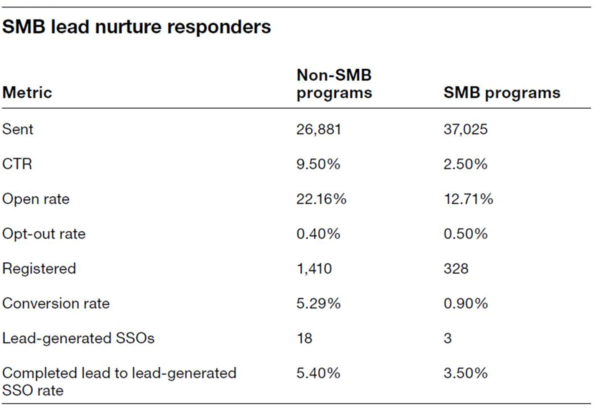A common practice in traditional marketing is to first choose a target market to focus on. You then align your organization’s strategies and messaging to create a campaign in that target market. But what happens when it becomes clear that the campaign you created isn’t working? How agile are you in terms of adjusting on the fly and adapting to the needs of your prospective customers?
The challenge
A campaign we ran at SAS targeted small to medium-sized businesses, or SMBs. We needed to come up with tailor-made messaging that would be distinct from similar campaigns we were launching targeted at larger, enterprise-level companies. To do that, we highlighted what we thought we re business needs, language and case studies that would resonate with the SMBs.
re business needs, language and case studies that would resonate with the SMBs.
But after the program launched and began, the results were disappointing. We saw lower-than-expected results for performance metrics including click-through rates and conversions. So we tweaked the messaging, offers and program structure to improve results. After crunching those numbers, the results came in – the campaign was still floundering.
We were now forced to take a fresh look. What had we done wrong? On reflection, we came upon an even more telling question: Did we actually need to separate SMBs from larger organizations? We started with an underlying assumption that the SMB market should be treated differently. Had that been a mistake?
The approach
To help guide us forward, we selected a roster of key performance metrics to analyze:
- E-mails sent.
- Open rates.
- Click-through rates.
- Opt-out rates.
- Conversions (those who filled out registration forms to receive the promoted asset).
- Lead-generated SSOs (an internal measure of conversions that we identify as leads that later progress to become sales opportunities).
- Rate of completed leads to SSOs.
We then looked at how the SMBs responded to the SMB-specific campaign compared to how they responded when they received the enterprise-level messaging.
The results
To our surprise, SMBs responded more strongly to the enterprise-level campaign (see the table below). Our assumption had been proved wrong. So we adjusted by closing the SMB-specific campaign and retargeted the SMBs with our enterprise-level messaging.
The takeaway for us was a reminder that we can’t afford to let our assumptions about the market hinder our ability to adjust to customers’ needs. In this situation, we relied on the power of analytics to provide the answers about what people wanted rather than continue in a losing cause.
You can best meet customers along their decision journey by relying on advanced analytics to increase the quality of a marketing campaign by using scoring, optimization and predictive capabilities. The standard spreadsheet-based reports that marketers used to rely on to see how their campaign performed have now shifted to interactive visualization dashboards to track the efficacy of their campaign, while making changes on the fly when necessary to ensure a campaign is reaching its potential. The biggest difference is that marketers now have these tools at their disposal. We no longer have to submit requests to the IT department to get this information.
How SAS can help
We've created a practical ebook to modernizing a marketing organization with marketing analytics: Your guide to modernizing the marketing organization.
Targeted campaigning using analytics is empowered by SAS Marketing Automation. If campaigns are created with analytical value scores as inputs, the need for “gut feel” marketing is removed. The result – knowing what your customers want and when they want it.
If you’re interested in learning more about SAS Marketing Automation features and techniques, check out our collection of free SAS Marketing Automation How Do I tutorials or register for our SAS Marketing Automation: Designing and Executing Outbound Marketing Campaigns course.
==
Editor’s note: This post is part of a series excerpted from Adele Sweetwood’s book, The Analytical Marketer: How to Transform Your Marketing Organization. Each post is a real-world case study of how to improve your customers’ experience and optimize your marketing campaigns.

